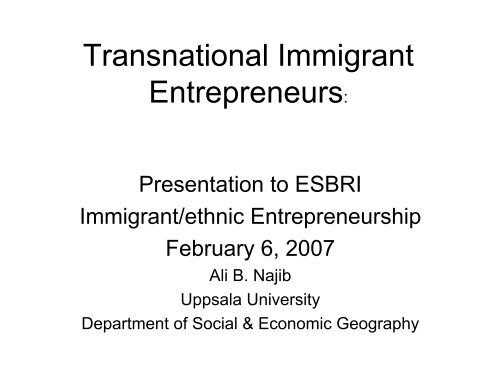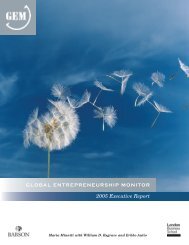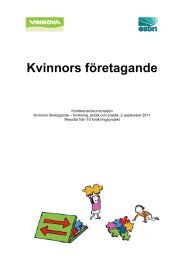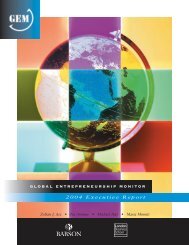Transnational Immigrant Entrepreneurs: - Esbri
Transnational Immigrant Entrepreneurs: - Esbri
Transnational Immigrant Entrepreneurs: - Esbri
Create successful ePaper yourself
Turn your PDF publications into a flip-book with our unique Google optimized e-Paper software.
<strong>Transnational</strong> <strong>Immigrant</strong><br />
<strong>Entrepreneurs</strong>:<br />
Presentation to ESBRI<br />
<strong>Immigrant</strong>/ethnic <strong>Entrepreneurs</strong>hip<br />
February 6, 2007<br />
Ali B. Najib<br />
Uppsala University<br />
Department of Social & Economic Geography
<strong>Transnational</strong>ism a profound shift in<br />
development<br />
Migration as the Human Face of Globalization<br />
Hyper-migration<br />
Difference today is<br />
1. Trade<br />
2. Travel<br />
3. Telecommunications<br />
4. Transfers<br />
2
Beyond Remittances<br />
1. Remittances are more than money.<br />
2. Indication of deeper, wider, more dynamic<br />
exchange within communities.<br />
3. These exchanges and actors are crucial to<br />
effective, relevant development work.<br />
4. Redefine communities in which we work and<br />
how we work in/with them.<br />
5. How to respond to new reality, new demands,<br />
new possibilities, new partners.<br />
3
Migration in transnational social<br />
spaces<br />
-<br />
Region of<br />
destination<br />
<strong>Transnational</strong> Social Spaces:<br />
Intensive cross border flows of people,<br />
money, goods & information<br />
Region<br />
of origin<br />
4
As a result:<br />
<strong>Transnational</strong>ism a profound shift in<br />
development<br />
<strong>Transnational</strong> communities<br />
• dispersed geographically, but<br />
• united by kin, culture, language, economics, etc.<br />
• Resources, knowledge and ideas are shared within<br />
community at speed of modern business<br />
• geography and national borders close to irrelevant.<br />
Leads to <strong>Transnational</strong> <strong>Entrepreneurs</strong><br />
5
Types of Ethnic and immigrant<br />
Enterprise<br />
1. Circuit firms<br />
2. Ethnic enterprises<br />
3. Cultural enterprises<br />
4. Return migrant enterprises, and<br />
5. Home country Counterpart<br />
enterprise<br />
6
The Response<br />
<strong>Transnational</strong> Enterprises<br />
1. Response to new opportunities of globalization<br />
2. Response to lower cost and greater availability<br />
of technologies of trade<br />
3. Response to existence of multi-stranded and<br />
deep cultural, national, ethnic ties.<br />
Old or/and New phenomenon?<br />
7
Importance for Destination Country<br />
Destination Country – France, Netherlands,<br />
Belgium, Spain, Italy, Sweden, etc.<br />
• Economic prospects of immigrants depend<br />
on host-country labour market as well as<br />
business (self-employment) opportunities<br />
• <strong>Immigrant</strong> entrepreneurs do better<br />
economically than their waged co-ethnics<br />
(Portes and Zhou 1999; Logan, Alba, and McNulty 1994; Wilson and Martin<br />
1982, probably not in Sweden? Mikael Hjerm 2004).<br />
• <strong>Transnational</strong> immigrant entrepreneurship do<br />
better in integration perspective?<br />
8
Importance for home country<br />
Home Country – Egypt, Morocco, Tunisia, Turkey, etc.<br />
• Access to new capital<br />
• Access to new (more profitable) markets<br />
– Large immigrant population in:<br />
• France and Netherlands Moroccan & Turks<br />
• Sweden Iraqis, Iranians, Turks and others Chileans.<br />
• <strong>Transnational</strong> immigrant entrepreneurship do<br />
better economically (HCs) than ethnic<br />
entrepreneurship?<br />
• Access to new technologies/ideas<br />
9
Five types of enterprises:<br />
Destination region<br />
Region of origin<br />
Circuit<br />
firm<br />
Cultural<br />
enterprise<br />
Ethnic<br />
enterprises<br />
Return migrant<br />
enterprise<br />
Home country<br />
Counterpart enterprise<br />
10
Migrant workers<br />
Migrant entrepreneurs<br />
Orientation<br />
Family<br />
Business<br />
Network<br />
Migrant network<br />
Business network<br />
Relation with<br />
region of origin<br />
Goods and<br />
remittances<br />
Input<br />
Output<br />
Impact on region<br />
of origin<br />
Basic needs<br />
Household level<br />
Employment<br />
Productivity<br />
Maas 2003<br />
Short term<br />
Long term<br />
11








